Amy's optimistic comment at the end of a recent post to the ultra list resonated
with me. I saved it in my "Motivational
Sayings" file, knowing that it would be appropriate for this entry.
I've often mentioned the importance of being able to successfully
adapt to changing circumstances in our lives. How quickly,
intelligently, and gracefully we can do that can make the difference
between misery and a more rewarding, happy life.
"Reinvention" is another way of explaining this process:
finding new purpose, focus, and momentum to reach our goals, whatever
they may be -- a new job or a different career, better health, an early retirement,
financial freedom -- fill in your own blanks with the things that
are important to you.
Ideally this is a continual pursuit of personal growth and
fulfillment, not just a reaction to the obstacles that get thrown in our
path.
This is the current "reinvention" I'm working on:
LIFE AFTER RUNNING
For me, running has been so much more than a past-time for the last
30+ years. It's even been more than a passion; it's
been my lifestyle and a large part of my identity for a long, long time.
During that time much of my life has revolved around running in
one way or another -- how I arranged my schedule, what I ate, how
much sleep I got, where I lived and traveled, who many of my friends
were, even what medical care I received.
I not only ran to stay fit, I also stayed fit so I could run.
My career always came before running. At least I had that priority
right. But when I had the opportunity to retire at 50, marry a man with
whom I had more in common, and live my dream of traveling around the
country to run and race while I was still young enough to do it (sort
of), I
reinvented myself big-time.
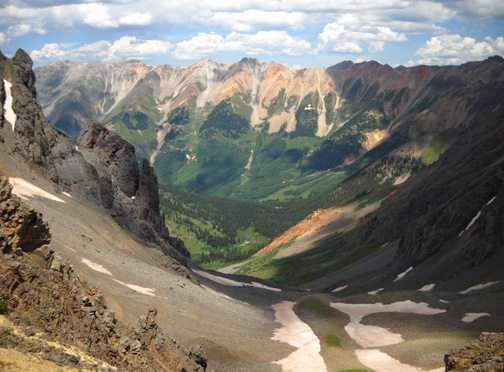
View toward Oscar's Pass from Grant-Swamp Pass on
the Hardrock 100 course (7-24-09)
I've often wondered how and when my running "career" would end. I wasn't planning on
finding out so soon, though.
I had hoped to continue running until my dying day (assuming my dying
day is in my 90s or 100s, not any time soon!). Like most folks in their
20s and 30s, I used to feel somewhat invincible. For the last couple of
decades, however, I've realized that just one accident or serious illness
could curtail my running (or life) at any second and I tried to
appreciate each run, knowing it could be my last one.
That's been particularly true the last couple of years, since first
learning about the deterioration in my knees.
Until then it was hard to think of very many situations short of death that
would "kill" my running. I've thought of an answer to almost any
catastrophe that could occur
-- anything to continue enjoying my passion.
For example, I figured that I'd keep
running even if one of my legs needed to be amputated. I know of several amputees who've overcome
serious accidents and run trail ultras. If they could rise above such
trauma and continue running, why not me?
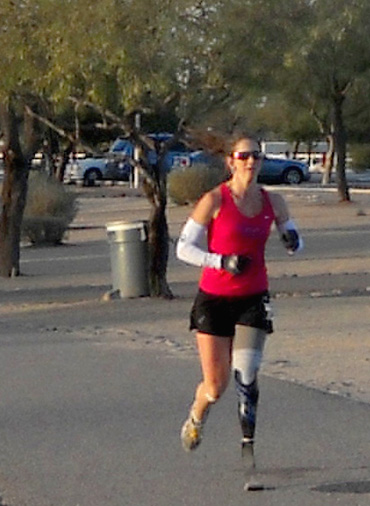
Below-the-knee amputee Amy Palmiera-Winters ran
130.4 miles
at Run to the Future 24-hour race on January 1
(first overall).
I've prided myself on my good health and excellent fitness level the
last thirty years. I worked hard for that but also had a lot of fun
along the way. I knew I had a couple of genetic risks for things that could
curtail the running part of my life but it was still a shock in September, 2007
when I learned that my running days would be coming to an end much
sooner than I'd hoped -- not because of an accident or
Alzheimer's Disease or breast cancer or a heart attack, but because
my knee cartilage was just about gone.
Unfortunately, there's not a whole lot you can do about that even in 2010,
at least to be able to continue doing ultra-distance walking or running.
I've adapted my running gradually since then by reducing my mileage,
increasing the proportion of miles I walk versus miles I run, avoiding
gnarly trails and steep down hills, strengthening my knees with weights, and doing more cycling to reduce the
stress on my knees. I ran my last ultra in September, right before
beginning Orthovisc
injections in both knees.
To my immense
relief, the Orthovisc has worked quite well so far. Time will tell
how long the injections last -- six months is average, and there
is apparently no limit medically to the number of times I can get
injections. It remains to be seen how often my insurance company will
subsidize it!
Now what? Do everything possible to continue this running lifestyle,
or adapt in some other way?
HOPING FOR NEW TECHNOLOGIES
Despite the initial success of the injections and the encouragement of optimistic,
equally-addicted running friends that I can continue running with
repeated doses of Orthovisc and/or eventual knee replacements . . . my research,
sports orthopedists,
and gut tell me that's not in my best interest.
As Dr. Johnson clearly
explained in September, the purpose of the Orthovisc injections is
to delay the need for knee surgery, not allow me to continue running (or
even walking) long distances.
I'd much rather be able to enjoy walking shorter distances for as
many years as possible than continue running or walking too much now,
hastening the need for knee surgery.
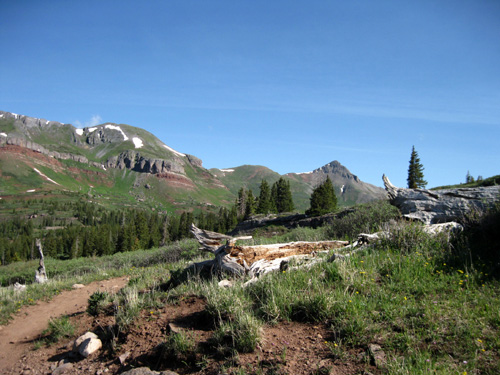
Colorado Trail segment between Molas
and Rolling passes near Silverton, CO (7-1-09)
There is one intermediate option between visco-supplementation (like
Orthovisc and Synvisc) that is still relatively experimental:
ACI, which stands for Autologous Chondrocyte Implantation. It involves
removing a little bit of cartilage from a patient's knee or another joint,
growing more of it over several weeks in a lab, and injecting it into the knee joint, where
hopefully it will continue to grow and cushion the knee.
The procedure gained some publicity after 41-year-old Olympic triple
silver medal swimmer Dara Torres had it done in one knee with minimal
cartilage; she couldn't even swim like she wanted to because of the pain in
her knee.
I first heard about her story on a CBS news broadcast and got
optimistic that maybe someday I can have similar surgery done if my insurance will
pay a significant portion of it (Dara's procedure cost about $60,000 for
ONE knee, and I've got TWO bad ones!).
This
article on the CBS website describes
the surgery as "radical" but it sounds a lot less radical to me than
total knee replacements!! According to the article, there is a more
advanced procedure undergoing trials now that is less invasive and has a
shorter recovery time.
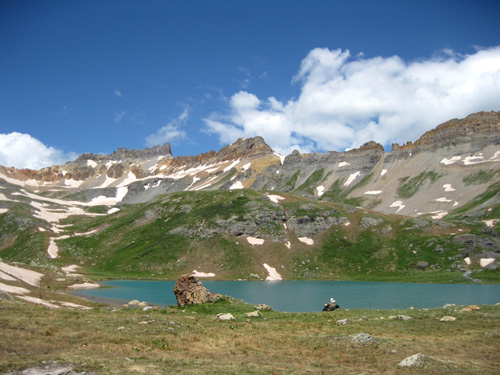
Jim relaxes in the Upper Ice Lake Basin near
Silverton, CO.
There are no roads up there, so I may never see it
again. (7-6-09)
I'm not pinning all my hopes on having this type of procedure done. According to
the research I've done so far with doctors and on the internet, my knees are likely beyond repair in this way
because too much cartilage has already been lost. Here is one articulate
explanation about the difficulty of
repairing cartilage damage.
Modern knee replacements are becoming commonplace (all those Baby
Boomers and their parents!) and allow most recipients to resume normal
activities. However, even the artificial knees that are designed for athletes don't last
very many years
with heavy continued use like running. I don't relish the idea
of knee surgery every time my future synthetic knees wear out from
going too many miles on them.
Until
and unless these devices significantly improve, or new scientific
advances to grow/replace cartilage become more effective, affordable,
and possible for my advanced knee deterioration,
I choose to adapt by becoming a walker/hiker for as many years as that
is feasible.
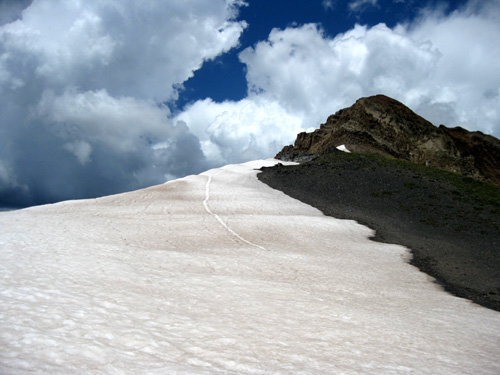
No roads up here, either: snow cornice on
Rolling Mtn. Pass in the San Juans.
The Colorado Trail is under several feet of
snow here. It eventually melted. (7-1-09)
And I've come to accept that even walking long enough to produce the
endorphins I crave, and the fitness level I desire, may not be possible
after I get my knees replaced. If some technology is developed that allows me to
run again, I'll certainly consider it but I'm not holding my breath.
I have a life to live in the meantime!
ADAPT OR DIE
One of the traits that running has helped me hone is adapting quickly to
changing circumstances.
No one can successfully complete long-distance training runs and events without adapting to
a plethora of variables that can occur during hours or days on the road
or trail. This applies to any sport where athletes compete over long
periods of time and distance -- marathons, ultra marathons, adventure runs,
cycling events, snowshoeing and skiing races, etc. -- in venues
ranging from deserts to mountains to jungles to the Arctic tundra.
Just getting to the starting line of such strenuous events is fraught
with pitfalls:
injuries, illnesses, time to train properly, level of fitness and
training at the time of the race, family or work glitches that end up
taking precedence, race cancellations or modifications, travel delays,
and more.
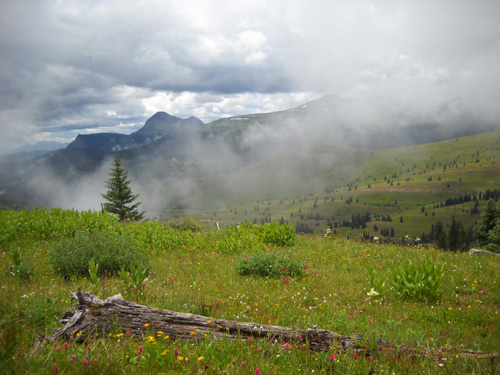
Storms can roll in fast at high
altitudes (Segment 25, Colorado Trail, 7-26-09)
On race day these competitors face more variables:
heat/cold, rain/snow, gale-force winds, lightning, forest fires,
condition of trails, unexpected course reroutes, getting off-course,
time cut-offs at aid stations, altitude problems, adjusting electrolytes
and calories,
dehydration, over-hydration, GI problems, blisters, fatigue, pain,
animal encounters, poisonous plants, and a myriad of other obstacles
that can change from hour to hour and place to place.
Those variables require constant adjustments
during long training runs and races. If endurance athletes don't learn to do this
successfully they not only might DNF (did not finish), they can even die from something
like heat exhaustion, hypothermia, HAPE, HACE, hyponatremia, serious injury,
and other catastrophes.
Although I had several brushes with death when running/hiking, namely
lightning strikes on various exposed mountain ridges and flooded stream
crossings, my closest encounter with death or serious injury during any
athletic endeavor came during last August's bike
crash during an
innocuous ride on a fairly smooth dirt road. I still have no clue what
caused that wreck.
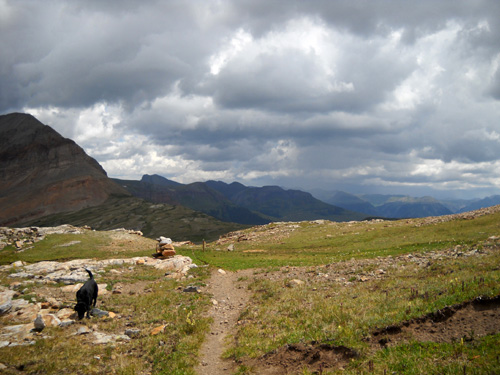
Another summer storm in the
Rockies (Segment 25, Colorado Trail, 7-29-09)
Life is full of ironies. It doesn't take a risky adventure to cause
serious injury or death.
Learning to be flexible and to adapt to circumstances are obviously
very useful skills to have in all areas of life, not just
running. And those traits will serve me well now that I'm faced with the
adjustments I have to make in a life without running.
No, giving up running is not a matter of life and death but the loss
of something or someone you love with all your heart can cause serious
psychological problems and even premature death if a person isn't able
to adequately adapt to the loss and move forward with renewed hope and
purpose.
Fortunately, I have many other interests -- physical as well
as cerebral -- to keep me busy and I plan to develop some new
ones, too. None of them are likely to replace all the benefits I got from
running, but they will keep me relatively fit and sane for the Next
Third.
THE NEXT THIRD??
Hopefully, the next 40% since I still have the goal of living to 100
. . .
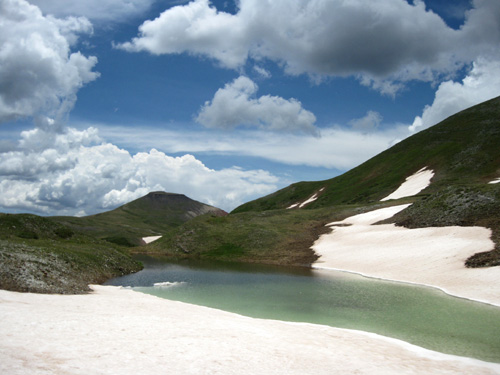
Summer comes late in the San Juan
high country.
This little lake is in the basin
below Rolling Mountain Pass. (7-1-09)
Here's the math:
- I focused on my education, career, and family life in my first thirty
years: the First Third.
- I largely focused on running the next thirty years -- the
Second Third -- not to
the detriment of my career, but to the detriment of my last marriage.
It
ended in an amicable divorce and my rewarding marriage to Jim.
What about the next thirty or forty years? That's the Next
Third.
What is my focus now? How will I "reinvent" myself?
That's one of the things I'm working on now. Only time will tell if I develop another life passion, athletic or
otherwise, that will
consume me in my remaining years as wholly as running did. I'm not sure
I've got the energy for something that intense any more! What's important
to me is that I
continue to seek a variety of interesting challenges for the rest of my life so my mind
and body don't vegetate.
I'm still me. My basic life goals remain the same;
they just don't include me running any more.
THE WEANING PROCESS
How long I stay involved on the periphery of the sport of ultra running
primarily depends on
how long Jim continues running races or being interested in volunteering at
them. We've been so preoccupied with other things in recent months that
he's starting to lose focus on his own lengthy running "career."
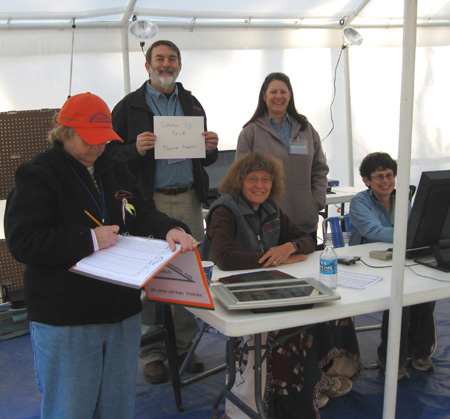
Umstead 100 is one of the races that really knows
how to treat its runners
AND volunteers well. (Sue at timing table,
center, 4-4-09)
In addition to the modifications I've already made to my running, there are some other signs that I'm weaning myself away from
the sport.
For example, I've already begun to lose interest in reading the internet ultra
list, to which I've subscribed for 12-13 years. Until my self-revelation in
December that it was a relief to not "have to" train and race any more,
I read almost every post to the list about training tips, race
reports, shoes and other gear, "bios" of new subscribers, recovery from
injuries, and many other relevant (and irrelevant but interesting)
topics.
The ultra list was a source of education and entertainment for me for
many years. Now I skip entire threads and read only those of special interest. I
still read most of what our friends and other favorite people write, regardless
of the topic, but now many more posts get deleted than read. (Jim's always
been able to do this!)
I still look forward to receiving UltraRunning magazine,
though. And I'm not ready to throw out all the running memorabilia I wrote
about in a
previous entry -- running logs,
books and old magazines, the more meaningful awards and shirts, pre-digital photos, etc.
I'll be selective when we return to Virginia and start weeding through
our possessions in preparation to putting our house up for sale. Some
things I'm just not ready to part with yet.
I'll still crew for Jim at ultras, support our ultra running friends,
and volunteer at some races. When the time comes that Jim either cannot or
chooses not to run
ultras any more, we'll have to decide about our level of involvement.
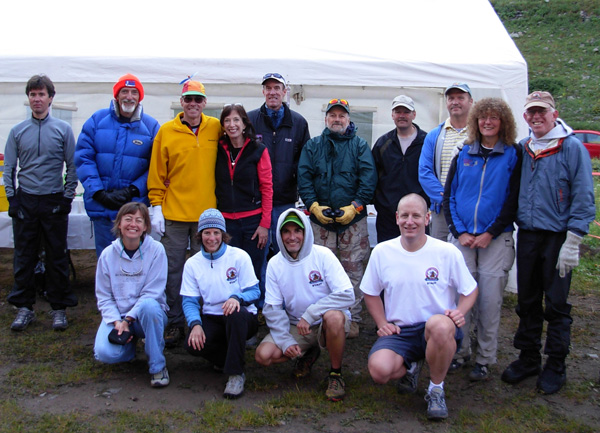
What a great crew of volunteers we had at Hardrock
in 2007
when Jim (far right) captained the Cunningham Aid Station.
(7-13-07)
Some "retired" ultra runners become race directors and/or active volunteers at races.
We have absolutely no desire to direct a race, especially if
we're full-timing in our RV. Continued volunteering
will interest us only if we're able to see enough friends at events to make
it rewarding. Sure,
we can make new friends but it's more fun to support the ones with whom
we already share some history. As our ultra running friends also age and
become less active in the sport, we're already seeing fewer familiar faces at
some races (particularly those under 100 miles) and more new ones. It's
just not the same level of camaraderie.
At the other extreme, many former ultra runners either become deeply
involved in other activities or can't bear to be around the sport any
more and just fade from the scene. The rest of us are left to wonder,
"Whatever happened to so-and-so?"
Time will tell how Jim and I eventually adapt to a life with no more running in
it -- remain on the periphery or fade into obscurity . . .
Continued in
part 2: mindful awareness
Happy trails,
Sue
"Runtrails & Company" - Sue Norwood, Jim O'Neil,
and Cody the Ultra Lab
Previous
Next
© 2010 Sue Norwood and Jim O'Neil